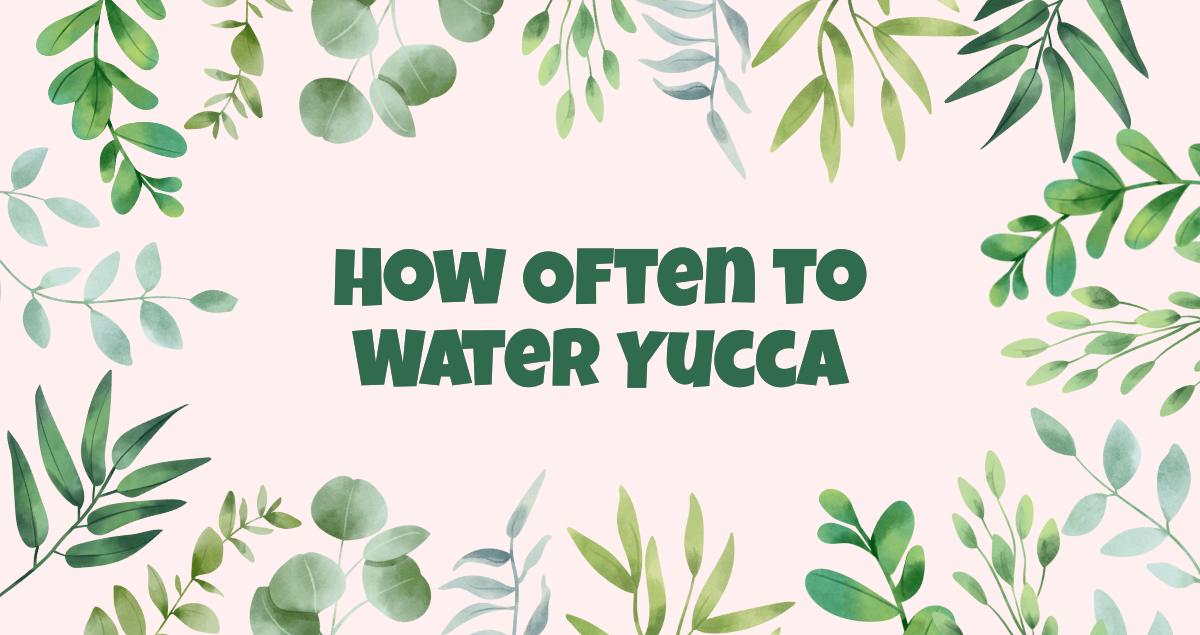Yucca plants are known for their striking appearance and ability to thrive in various environments. However, when it comes to watering these plants, it is important to understand their specific needs to ensure their health and vitality. This article will provide a comprehensive guide on how often to water yucca plants, taking into consideration various factors that affect their watering requirements.
Table of Content
How Often to Water Yucca
Water yucca plants every 1-2 weeks during the growing season, allowing the soil to dry out between waterings. In winter, reduce watering to once a month. Ensure good drainage to prevent root rot, and adjust watering frequency based on environmental conditions and plant needs.
Factors to Consider for Watering Yucca Plants
Before determining the watering frequency for yucca plants, it is essential to understand the fundamental principles of watering. Yucca plants are native to arid regions and have adapted to survive in dry conditions. Therefore, they are highly tolerant of drought and can withstand long periods without water. Overwatering can be detrimental to yucca plants, as it can lead to root rot and other issues. It is crucial to strike a balance between providing enough water for the plant's needs and avoiding excessive moisture.
Evaluating Yucca Plant Watering Needs
Several factors should be considered when determining the watering frequency for yucca plants. These include the plant's age, size, and growth stage, as well as the climate and environmental conditions. Young yucca plants and those in active growth stages require more frequent watering compared to mature plants. Additionally, the climate plays a significant role in determining the watering needs. Yucca plants in hot and dry climates may require more frequent watering, while those in cooler and more humid environments may need less water.
Assessing Yucca Plant Soil Moisture
Checking and maintaining the appropriate soil moisture level is crucial for the health of yucca plants. The soil should be well-drained to prevent waterlogging, which can lead to root rot. One way to assess soil moisture is by sticking your finger about an inch into the soil. If it feels dry at that depth, it is time to water the plant. However, if the soil feels moist, it is best to wait before watering again. It is important to note that yucca plants prefer to dry out between waterings, so it is better to underwater than overwater.
Yucca Plant Watering Schedule
Creating a suitable watering schedule for yucca plants is crucial to ensure their optimal growth. As a general rule, yucca plants should be watered deeply but infrequently. This means thoroughly saturating the soil until water drains out of the bottom of the pot or seeps into the ground. However, the frequency of watering will vary depending on the factors mentioned earlier. It is recommended to water yucca plants every 7-10 days during the growing season and reduce the frequency during dormant periods.
Adjusting Watering Frequency Based on Environmental Factors
Environmental conditions such as temperature, humidity, and sunlight exposure can affect the watering requirements of yucca plants. In hot and dry climates, yucca plants may require more frequent watering to compensate for the increased evaporation. Similarly, yucca plants in areas with low humidity may need more water compared to those in more humid environments. It is essential to monitor the soil moisture and adjust the watering frequency accordingly to ensure the plant's needs are met.
Signs of Overwatering Yucca Plants
Overwatering yucca plants can have detrimental effects on their health. Some signs of overwatering include yellowing or wilting leaves, root rot, and a foul odor coming from the soil. If these symptoms are observed, it is crucial to reduce the watering frequency and allow the soil to dry out before watering again. Proper drainage and avoiding waterlogged conditions are essential to prevent overwatering.
Signs of Underwatering Yucca Plants
Underwatering can also negatively impact the health of yucca plants. Signs of underwatering include shriveled or drooping leaves, dry soil, and slow growth. If these indications are observed, it is important to increase the watering frequency and ensure that the soil is adequately moist. However, it is essential to strike a balance and avoid overcompensating by overwatering the plant.
Watering Techniques for Yucca Plants
When watering yucca plants, it is important to use effective techniques to ensure optimal growth. Water should be applied directly to the soil, avoiding wetting the leaves or stem. This helps prevent fungal diseases and rot. It is also beneficial to water deeply, allowing the water to penetrate the root zone. Mulching the soil around the plant can help retain moisture and reduce the frequency of watering. Regularly monitoring the soil moisture and adjusting the watering technique based on the plant's needs is crucial for its overall well-being.
Watering Yucca Plants in Different Seasons
The watering frequency and amount for yucca plants may need to be adjusted based on seasonal variations. During the growing season, which is typically spring and summer, yucca plants may require more frequent watering to support their active growth. In contrast, during the dormant period in fall and winter, the watering frequency should be reduced to allow the plant to rest. It is important to consider the plant's growth stage and environmental conditions when determining the watering needs in different seasons.
Common Mistakes to Avoid When Watering Yucca Plants
To maintain the health and vitality of yucca plants, it is important to avoid common watering mistakes. Overwatering is one of the most common pitfalls that can lead to root rot and other issues. It is crucial to allow the soil to dry out between waterings and avoid waterlogged conditions. Another mistake to avoid is underwatering, as this can cause the plant to become stressed and hinder its growth. Regularly monitoring the soil moisture, adjusting the watering frequency based on the plant's needs, and providing proper drainage are essential to avoid these mistakes.
Conclusion
In conclusion, understanding how often to water yucca plants is crucial for their overall well-being. By considering factors such as the plant's age, size, growth stage, climate, and environmental conditions, it is possible to create a suitable watering schedule. Regularly assessing the soil moisture, adjusting the watering frequency based on environmental factors, and using effective watering techniques are essential for the optimal growth of yucca plants. By avoiding common watering mistakes and providing the right amount of water at the right time, yucca plants can thrive and add beauty to any space.

